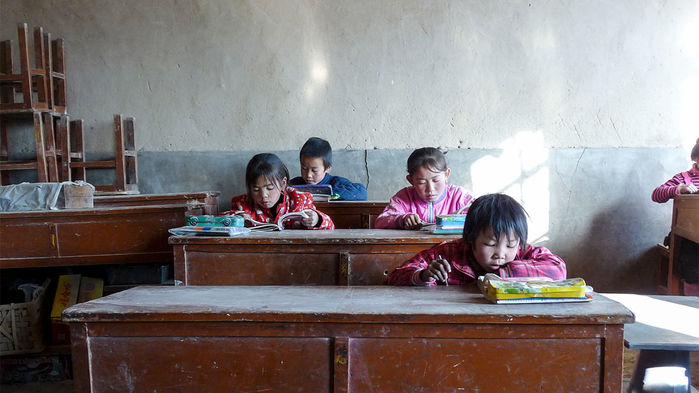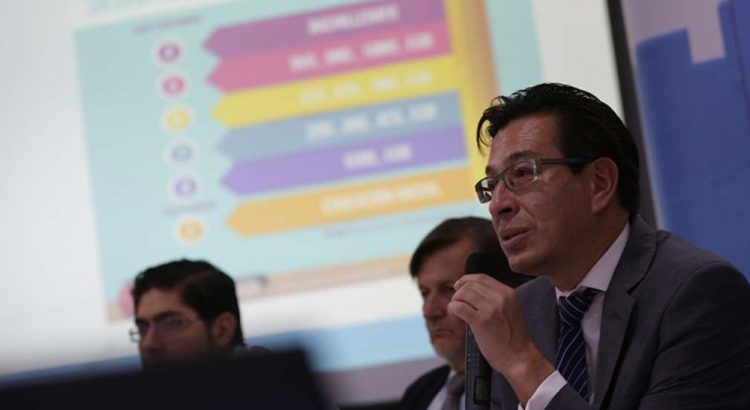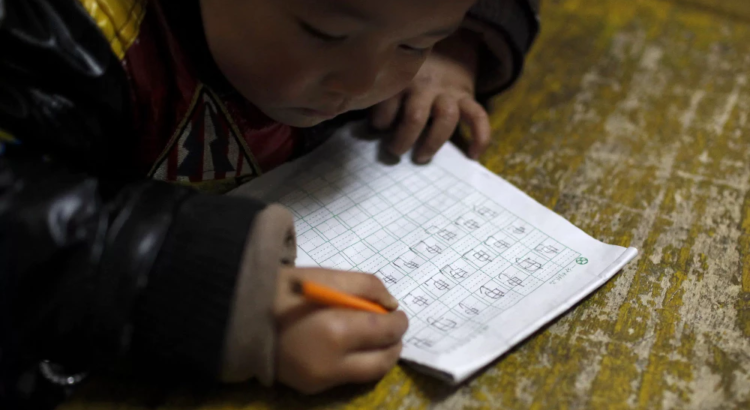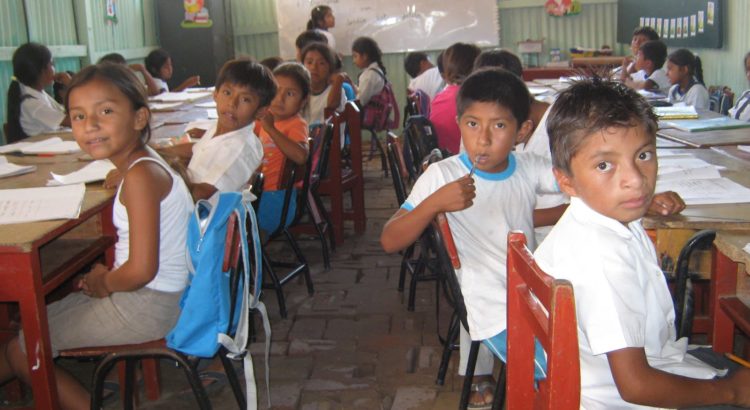China/Septiembre de 2017/Fuente: Science
Resumen: En otros lugares de este centro de educación infantil en el centro de China, los jóvenes están montando caballos en balsa, trepando en un gimnasio en la selva, pulgares a través de libros ilustrados o participando en la lectura en grupo. Una vez a la semana, los cuidadores reciben entrenamiento individualizado sobre cómo leer a los niños pequeños y jugar juegos educativos. El centro forma parte de un ambicioso experimento que Rozelle está dirigiendo, que busca encontrar soluciones a lo que él ve como una crisis de proporciones gigantescas en China: el retraso intelectual de aproximadamente un tercio de la población. «Este es el mayor problema que China está enfrentando que nadie ha oído hablar nunca», dice Rozelle, profesor de la Universidad de Stanford en Palo Alto, California. Las encuestas realizadas por el equipo de Rozelle han encontrado que más de la mitad de los estudiantes de octavo grado de las zonas rurales pobres de China tienen coeficientes de inteligencia por debajo de 90, dejándolos luchando para mantenerse al día con el currículo oficial. Un tercio o más de los niños rurales, dice, no completan la secundaria. Rozelle hace un pronóstico sorprendente: Alrededor de 400 millones de chinos en edad laboral, dice, «están en peligro de convertirse en discapacitados cognitivos».
Glasses askew and gray hair tousled, Scott Rozelle jumps into a corral filled with rubber balls and starts mixing it up with several toddlers. The kids pelt the 62-year-old economist with balls and, squealing, jump onto his lap. As the battle rages, Rozelle chatters in Mandarin with mothers and grandmothers watching the action.
Elsewhere in this early childhood education center in central China, youngsters are riding rocking horses, clambering on a jungle gym, thumbing through picture books, or taking part in group reading. Once a week, caregivers get one-on-one coaching on how to read to toddlers and play educational games. The center is part of an ambitious experiment Rozelle is leading that aims to find solutions to what he sees as a crisis of gargantuan proportions in China: the intellectual stunting of roughly one-third of the population. «This is the biggest problem China is facing that nobody’s ever heard about,» says Rozelle, a professor at Stanford University in Palo Alto, California.
Surveys by Rozelle’s team have found that more than half of eighth graders in poor rural areas in China have IQs below 90, leaving them struggling to keep up with the fast-paced official curriculum. A third or more of rural kids, he says, don’t complete junior high. Factoring in the 15% or so of urban kids who fall at the low end of IQ scores, Rozelle makes a stunning forecast: About 400 million future working-age Chinese, he says, «are in danger of becoming cognitively handicapped.»
Among Chinese academics, that projection «is controversial,» says Mary Young, a pediatrician and child development specialist formerly of the World Bank Institute in Washington, D.C. But although experts may debate the numbers, they are united on the enormity of the problem. «There is definitely a tremendous urban-rural gap» in educational achievement, says Young, who is leading pilot interventions for parents of young children in impoverished rural areas for the government-affiliated China Development Research Foundation in Beijing.
While China’s dynamic urban population thrives, much of rural China is mired in poverty. More than 70 million people in the countryside live on less than $1 a day, according to the World Bank, and children have it particularly hard. On a recent visit to Shaanxi province, at a group of farmsteads isolated in a remote valley, a 27-year-old mother of two says that she would like to send her kids to preschool. But she would have to rent an apartment in town to do so—a prohibitive expense.
Many parents migrate to the booming cities for work, leaving children with grandparents. (China’s household registration system requires that children enroll in schools in the district where their parents are registered.) Left-behind children tend to leave school early, eat poorly, and have little cognitive stimulation in the crucial first years of life. Grandparents, with limited education themselves, are poorly equipped to read to the next generation. They sometimes carry swaddled infants on their backs while working their fields, which delays infant motor development, Young says.
Such early deprivation, Rozelle and others say, limits kids’ potential for success in life. «There is a massive convergence of evidence» that development in the first 1000 days after a baby’s conception sets the stage for later educational achievement and adult health, says Linda Richter, a developmental psychologist at the University of the Witwatersrand in Johannesburg, South Africa, who doesn’t work with Rozelle.
China’s millions of at-risk children could threaten its future. Economic modeling shows that in some low- and middle-income countries, such as India and Tanzania, «the gross domestic product lost to stunting can be more than a country’s spending on health,» explains Richter, who helped produce a series of papers on early childhood development published online in The Lancet last October. Conversely, she says, «There is a special window of opportunity» for interventions that bolster health and improve parenting.

Luo Lie, 5, does eye exercises at a rural school. Like many of his peers, he is being raised by grandparents.
That’s what Rozelle is setting out to prove—on an unprecedented scale. In 100 villages across Shaanxi, his team of Chinese and foreign collaborators is following 1200 baby-caregiver pairs; half attend the enriching early education centers and half serve as controls. If the intervention works, Rozelle says his team will seek to convince authorities to establish early education centers nationwide. «It will keep China from collapsing,» he says.
Rozelle’s earlier experiments on health interventions in China had «a real impact on the lives of poor people,» says Howard White, a developmental economist with the Oslo-based Campbell Collaboration, which reviews economic and social studies. Rozelle’s group, he says, has been «very successful testing things on a small scale, taking them up to the provincial level, and using the findings to influence national policy.» Now, Rozelle hopes to have a similar impact with parenting.
Rozelle followed an unlikely path to becoming a crusader for China’s infants. He started studying Mandarin in middle school because his father thought it would be a useful skill, and he pursued finance as an undergraduate at the University of California (UC), Berkeley. But he put his courses on hold to spend 3 years studying Chinese in Taiwan. Seeing the island’s emergence as an Asian Tiger «got me excited about Asian development,» he says.
Later, the poverty he observed backpacking through Southeast Asia and in South America, where he spent 2 years studying Spanish, instilled in him a concern about economic inequality. That led him to pursue a master’s degree in development economics at Cornell University. Development economics was «a new, wide-open field,» he says. And he had an advantage. «Not too many development economists speak Chinese.»
Returning to Cornell for his Ph.D., he began a varied academic career in which China was the one constant. At Stanford and UC Davis, he explored such topics as irrigation investment, genetically modified cotton, and microcredit programs for rural poor. These efforts netted him a national Friendship Award, the highest honor given to foreigners for contributions to China, in 2008. He is also the longtime chairperson of an advisory board to the Chinese Academy of Sciences’s (CAS’s) Center for Chinese Agricultural Policy.
Rozelle’s unorthodox path through academia is matched by his quirky sense of humor. At a recent public talk in English to a general audience in Shanghai, China, he mimed cradling an infant in his arms while he talked about rural parenting. He explained that studies show that investing in early childhood education pays off for society, whereas spending on adult education has negative returns. «You guys are done, sorry,» he told the crowd.
In the mid-2000s, Rozelle and his colleagues shifted their focus from agriculture to education. China’s economy was growing rapidly, but «children from rural areas with poor educations or in bad health didn’t have the capabilities» to take advantage of new economic opportunities, says Luo Renfu, a longtime Rozelle collaborator and economist at Peking University in Beijing.

In Anshun, China, Luo Hongni, 11 (left), and her brother Luo Gan, 10 (right), carry flowers to be used as animal feed.
The result is a widening gap between urban and rural educational achievement in China, Rozelle says. Many urbanites fit the stereotype of «tiger» parents, pushing kids to excel in school. After hours, their schedules are packed with music and English lessons and sessions at cram schools, which prepare them for notoriously competitive university entrance exams. More than 90% of urban students finish high school.
But only one-quarter of China’s children grow up in the relatively prosperous cities. Rural moms have high hopes for their children; Rozelle’s surveys have found that 75% say they want their newborns to go to college, and 17% hope their child gets a Ph.D. The statistics belie those hopes: Just 24% of China’s working population completes high school.
Rozelle believes such numbers bode ill for China’s hopes of joining the ranks of high-income countries. Over the past 70 years, he explains, only 15 countries have managed to climb from middle- to high-income status, among them South Korea and Taiwan. In all those success stories, three-quarters or more of the working population had completed high school while the country was still in the middle-income bracket. These workforces «had the skills to support a high-income economy,» Rozelle says. In contrast, in the 79 current middle-income countries, only a third or less of the workforce has finished high school. And China is at the bottom of the pack. School dropouts don’t have the skills needed to thrive in a high-income economy, Rozelle says. And, worryingly, the factory jobs that now provide a decent living for those with minimal training are moving from China to lower-wage countries.
Rozelle thinks a lack of opportunity isn’t the only factor holding back China’s rural children. Physically and mentally, they are also at an increasing disadvantage, hampering their performance in school and their prospects in life.
Childhood in the other China
Compared with peers in the cities, rural kids have higher rates of malnutrition, uncorrected vision problems, and intestinal parasites. Many rural parents leave kids in the care of grandparents. The result, according to a team of economists: the intellectual stunting of roughly one-third of China’s population.

In 2006, Rozelle gathered many of his research collaborators into a Rural Education Action Program (REAP). Based at Stanford, it has key partner institutions in China, including top schools, such as Peking University, and CAS’s Center for Chinese Agricultural Policy in Beijing, which gives REAP credibility with national authorities. REAP also has connections with provincial universities and, through their professors, ties to local officials. (To avoid the scrutiny China gives nongovernmental organizations, Rozelle emphasizes that REAP is an academic entity conducting research.)
REAP’s initial studies focused on the quality and cost of rural education. But Rozelle became aware of health issues during a 2009 visit to a rural school with Reynaldo Martorell, a maternal and child health and nutrition specialist at Emory University in Atlanta. «After lunch, all the kids were napping; Rey said they should be running around,» Rozelle recalls. Martorell suspected malnutrition, and a preliminary survey proved him correct. Over several years, Rozelle’s team conducted 19 surveys in 10 poor provinces covering 133,000 primary school kids. They found that 27% were anemic, an indication of malnutrition; 33% had intestinal worms; and 20% had uncorrected myopia. «If you’ve got one of these three things,» Rozelle says, «you’re not going to learn because you’re sick.»
REAP followed up with trial interventions. At 200 schools, they checked each child’s vision and gave them a math test. Then, in half the schools, the kids who needed them got free glasses. A year later, the math scores of the kids with glasses had improved far more than those of peers in the other schools. Vitamin supplements and deworming yielded similar results. Luo says these and other findings helped convince the central government in 2011 to establish a school lunch program now benefiting 20 million rural students daily. «What impresses me about Scott,» says Martorell, «is that his work does not end with just publications; he is deeply committed to making sure government officials become aware of the problems and solutions.»
But Rozelle believed that he might achieve more by starting with younger children, persuaded by the work of economists showing that investment in the first 1000 days of life yields economic dividends. As he puts it: «The development economics field discovered babies in the past five or so years.» Adversity early on—malnutrition or neglect of an infant’s physical and emotional needs, for example—can leave cognitive deficits that persist for life. And in REAP, Rozelle had an organization that could do rigorous studies of interventions and their benefits.

Fluent in Mandarin, Stanford University economist Scott Rozelle enjoys interacting with the rural children in his intervention programs.
In 2013, REAP launched a study enrolling more than 1800 babies, ages 6 to 12 months, and their caregivers from 348 villages in impoverished Shaanxi province. A team took blood samples and measured the height and weight of each infant. An evaluator gave each baby a widely used test—the Bayley Scales of Infant and Toddler Development—that measures cognitive, language, and motor skills. Each caregiver answered a questionnaire used to assess the infant’s social and emotional status. The tests were repeated three times at 6-month intervals. The team also tracked whether and when a mother had migrated away for work.
On the bright side, Rozelle says, the tests indicated rural kids «don’t need help with their motor skills.» But 49% of the babies were anemic. And 29% scored below normal on the Bayley test: nearly twice the 15% of babies that naturally fall at the low end of intelligence tests in any population.
The researchers initially focused on nutrition, providing vitamins in the trial’s intervention arm. But follow-up tests showed that the supplements had marginal impact and that mental development scores deteriorated in both intervention and control groups.
At that point, Rozelle recalls, the team began to think, «Maybe it’s a parenting problem.» In spring 2014, REAP started asking caregivers in their study about parenting practices. Only 11% had told a story to their children the previous day, fewer than 5% had read to their children, and only a third reported playing with or singing to their children.
The situation is particularly fraught for «left-behind» children. Fully one-quarter of Chinese children under age 2 are left in the care of relatives at some point, according to UNICEF statistics. Grandparents often end up as the caretakers—and many «are still in a survival mode of thinking,» without the time, energy, or education to read to their grandchildren, Young says. The test scores confirm a devastating impact: After mothers left home to work in another city, mental development scores among their children declined significantly and socio-emotional indices «fell apart,» Rozelle says. The declines were greatest when a mother left during the child’s first year.
REAP was already adapting what’s known as the Jamaican intervention. Sally Grantham-McGregor, a physician and child development specialist, devised the strategy to help developmentally stunted children she observed while at the University of the West Indies in Kingston in the 1970s and 1980s. The Jamaican intervention relied on home visits to teach mothers, one-on-one, how to interact with their toddlers using books and toys designed to raise cognitive, language, and motor skills. The REAP team enlisted child education specialists and psychologists at Shaanxi Normal University in Xi’an, the province’s capital, to translate and adapt the teaching materials. For coaches, REAP turned to China’s National Health and Family Planning Commission, which was seeking new roles for its 1.5 million workers, who had enforced the country’s now-ended one-child policy.
REAP then took 513 children-caregiver pairs from the 1800 participants and split them into intervention and control groups. For the next 6 months, the newly trained family planning workers visited intervention homes weekly for coaching using the Jamaican method. In the intervention group, when the mother was present the baby’s Bayley scores rose to normal. But when a grandmother was raising the child, the Bayley score barely budged. «We’re working hard to figure out why,» Rozelle says.
The in-home visits were expensive, trainers sometimes skipped the most isolated families, and caretakers did not always comply. The coaching also did little to relieve the isolation of kids who did not have playmates, or of their mothers. A questionnaire given to mothers who remained at home with their children—often living with in-laws far from their own families and friends—suggested that 40% of them show signs of depression and could benefit from psychiatric help.

At early childhood development centers, coaches work with caregivers to bolster such parenting skills as reading to children.
Those findings set the stage for REAP’s most ambitious experiment yet. To deliver services more cost-effectively, ensure that coaching sessions take place, and relieve isolation for toddlers and caregivers, the team over the past year set up 50 early childhood development centers in villages in Shaanxi province. The centers cost an average of $10,000 each to furnish and equip; their annual running costs range from $60,000 to $100,000. REAP raised the money from charitable foundations and philanthropists. The Shangluo facility, opened in May, is the first of several «supercenters» that will be located in apartment complexes being built in provincial towns to encourage rural residents to move off their isolated plots.
The REAP team will chart the progress of kids who visit the centers against children in 50 villages lacking them. Typical among those children is a 26-month-old girl being raised by her paternal grandparents in the village of Wanghe. Their house sits among a cluster of ramshackle buildings at the end of a dirt track. There are no playmates her age nearby. Her father works a 2-hour drive away in Xi’an, making it home only several times a year. Her mother has deserted the family. The grandmother, the main caregiver, did not even attend primary school. No toys or books are in sight. At an age when most kids have started forming two-word phrases, the girl barely talks. Not surprisingly, she scores dismally on the development test.
Rozelle says that when he sees kids in the randomly selected control villages, «I often want to take them in my arms and move them to the treatment village.» But randomized trials are key to demonstrating the benefits of the intervention. Few countries have comparable programs providing all-around support for mothers and babies during a child’s first 1000 days. Richter says there are a lot of unanswered questions about how to scale up interventions and adapt them to different cultures, how to support mothers at risk of depression, and how early interventions dovetail with later educational programs.
REAP’s studies might provide some answers. The first assessment of the childhood education centers will be done in early 2018. «We hope to follow the kids for as long as we can find funding,» says Wang Lei, a Shaanxi Normal University economist and a REAP affiliate. And Rozelle is already trying to convince the central government to set up centers in 300,000 villages across the country. Authorities could solve China’s rural cognitive deficit problem, Rozelle says, «if they knew about it and put their minds to it.»
The caregivers taking advantage of the centers are convinced of their value. At a center in Huangchuan, a village 30 kilometers north of Shangluo, Zhang Yanli says she has learned a lot about parenting and can see how quickly her 18-month-old daughter is picking up verbal and social skills. The young mother gestures to her older daughter, who is four-and-a-half years old. «I wish there had been a center for her.»
Fuente: http://www.sciencemag.org/news/2017/09/one-three-chinese-children-faces-education-apocalypse-ambitious-experiment-hopes-save
















 Users Today : 2
Users Today : 2 Total Users : 35460265
Total Users : 35460265 Views Today : 2
Views Today : 2 Total views : 3418970
Total views : 3418970